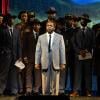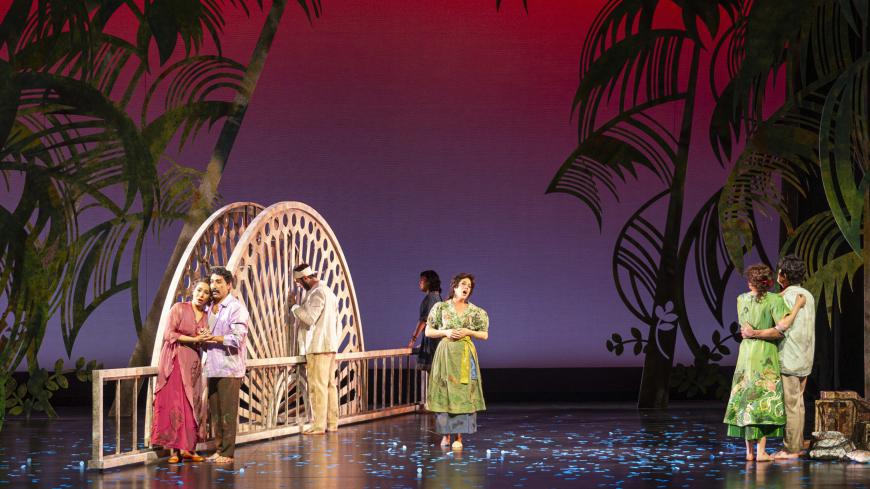
From its beginnings, opera has celebrated the magic powers of song — think of Claudio Monteverdi’s Orfeo, the oft-cited “first” opera, whose singer-hero can magically tame the demons of hell with his music. Further back, the link between music and magic was embedded in the Latin word carmen, meaning both a magic charm and a charming song. Even today, we speak casually of the powerful concept of the diva, perhaps forgetting that in Italian the word means not only a theatrical star but also a goddess.
Opera San Jose’s current offering is a rich and emotional opera by the late Mexican composer Daniel Catán. Florencia en el Amazonas is a resonant story about an opera singer — a diva — whose voice not only thrills the listener but also inspires the voices of others. OSJ’s production opened at the California Theatre over the weekend (I saw Sunday’s performance) and runs through May 5.
On a steamboat on the Amazon in the early 20th century, Florencia (“La Grimaldi”) is traveling to perform at the Teatro Amazonas in Manaus (an actual opera house deep in the Brazilian interior). Oddly — given the stereotyped diva label — La Grimaldi is so private that no one on the boat realizes who she is.
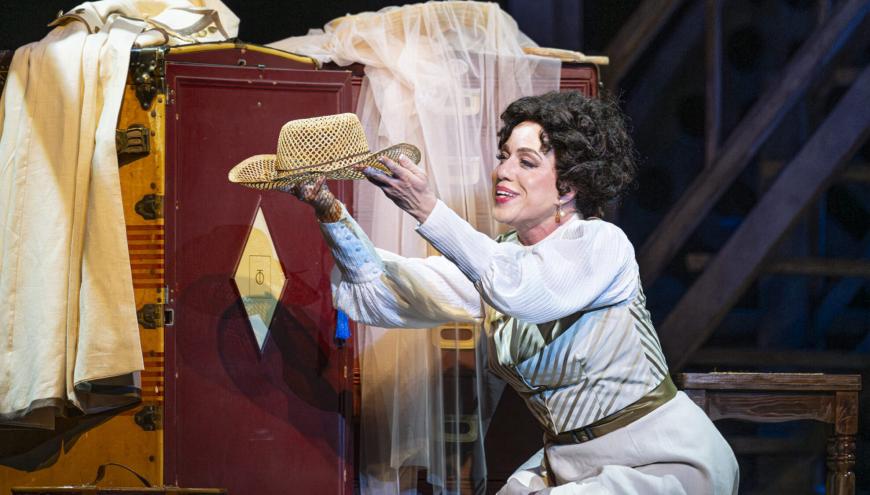
Everyone onboard needs help — a married couple fallen out of love, a writer unable to finish a book and afraid of love, a boat hand trapped in a dead-end job. Florencia herself is in a crisis of self-doubt, conflicted about having left her lover, a butterfly hunter, years ago; she had promised to return after achieving international fame and has done so now after decades, only to learn that her lover has disappeared in the Amazonian jungle.
Taking its cue from magical realist fiction (made famous by Gabriel García Márquez and Isabel Allende), the opera melds the magic of the Amazon with the magic of opera, allowing journey and song to free the characters from their various entrapments, inspiring them to love and live again. The opera works with a fluid and nonlinear sense of time and causation, aspects that fit beautifully with Catán’s late-Romantic musical language.
The sense of a benevolent magic permeates Catán’s lush composition, as well as the Spanish-language libretto of Marcela Fuentes-Berain (a student of Márquez’s). Supertitles gave the dialogue in both Spanish and English. Catán writes with an obvious delight for the excesses of late-Romantic sound (think Puccini and Richard Strauss) — big brass and percussion coupled with heroic vocal mountaineering. Catán writes especially powerfully for tenor and soprano, who repeatedly soar to the very tops of their ranges.
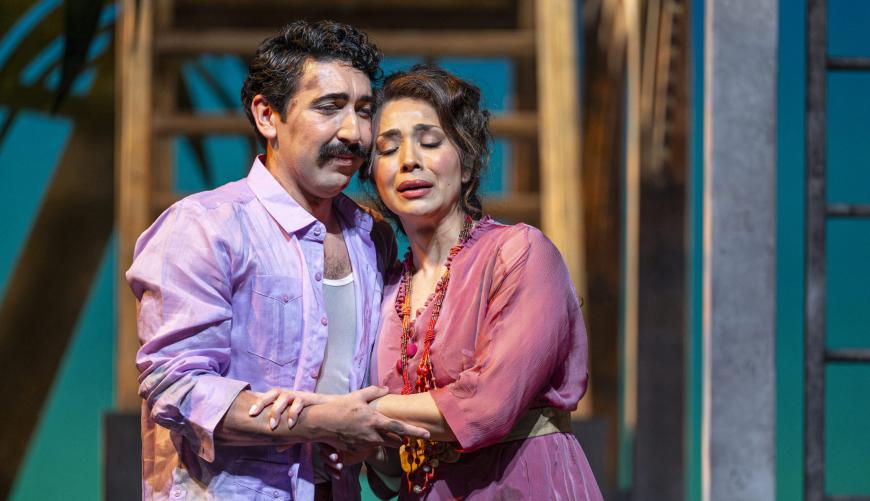
First performed in 1996, Florencia debuted at New York’s Metropolitan Opera last year; the current San Jose production is the opera’s Bay Area premiere. The big scale of Florencia demands strong singers, and OSJ excelled in finding them. When the original Florencia bowed out, the Cuban-born soprano Elizabeth Caballero (a former Adler Fellow) stepped in with a terrific performance. She drove the emotional arc of the production straight through to her character’s final aria, in which Florencia learns to forgive herself and accept the death of her lover. When Caballero was singing, Tosca (another unhappy diva) seemed, magically, never far away.
Ricardo José Rivera, an OSJ regular, brought his clarion baritone to the role of Riolobo, a benevolent shaman who charms the storms in Act 1 and enlists the aid of the river deities to save the steamboat. Soprano Aléxa Anderson — though well known on other Bay Area stages — made a fine debut with the company as the writer Rosalba, who learns from Florencia how to overcome her fears of love. As Rosalba’s ardent and eventually successful lover, tenor César Delgado, playing the boatman Arcadio, shone in his Act 1 aria about his hopes to fly an airplane.
Mezzo-soprano Guadalupe Paz and baritone Efraín Solís, as the married couple Paula and Alvaro, turned some comic encounters early in the opera into a moving scene of reunion after Alvaro, presumed dead in the storm, is revived by Paula’s ardent incantation. OSJ artist-in-residence Vartan Gabrielian, as the steamboat captain, was appropriately commanding, as well as tenderly empathetic with his restive nephew, Arcadio.
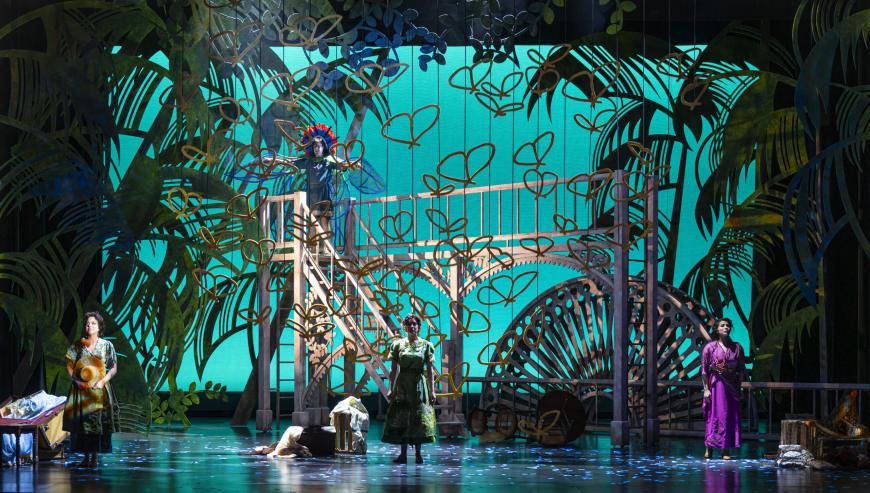
Director Crystal Manich and scenic designer Liliana Duque Piñeiro beautifully captured the opera’s lush atmosphere and maintained the fluidity that magical realism depends upon.
The excellent orchestra — an eighth character in the drama — was conducted by Joseph Marcheso. In grand Puccini style, Catán’s orchestration unabashedly bolsters the vocal climaxes of the arias at high volume; given the strong voices of the cast, the singers were usually still audible, but the overall effect of so many grand arias was of too much orchestral volume, sustained too long. Even with all the Romantic glory of sound, I longed for moments of quiet.
In the moment, it was a joy to experience the magic of this magical realism, but on reflection I felt that the opera fell short in the realism department. Perhaps it’s too much to ask of an opera set a century ago that it engage with the current harsh realities of the Amazon — widespread deforestation, the plight of Indigenous peoples, the extinction of species. In the time of the story, these were perhaps not matters of worldwide concern. But they are now, and it seems strange not to address such issues, at least in the program book, if not in the production itself.



